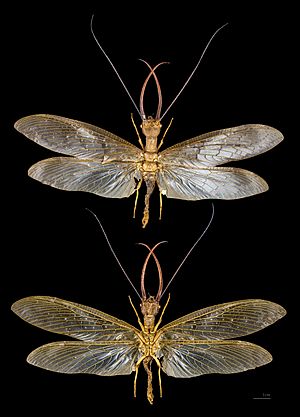Megaloptera facts for kids
Quick facts for kids MegalopteraTemporal range: Permian - Recent
|
|
|---|---|
 |
|
| Alderfly Corydalus cornutus | |
| Scientific classification | |
| Kingdom: | |
| Phylum: | |
| Class: | |
| Infraclass: | |
| Order: |
Megaloptera
Latreille, 1802
|
| Families | |
|
Corydalidae |
|
Megaloptera is an order of insects. This group includes fascinating creatures like alderflies, dobsonflies, and fishflies. There are about 300 known species of Megaloptera around the world. These insects are known for their unique life cycle, which involves living in water during their young stages.
Contents
Understanding Megaloptera
Megaloptera means "large wings" in Greek. This name fits well because many of these insects have impressive, net-like wings. They are part of a larger group of insects called Neuropterida. This group also includes lacewings and antlions. Megaloptera are considered ancient insects. Their fossils show they have been around since the Permian period. That was millions of years ago!
What Do Megaloptera Look Like?
Adult Megaloptera are usually medium to large-sized insects. They have two pairs of wings that are often clear with many veins. When they are resting, they hold their wings folded over their bodies. Their antennae are long and thread-like. They also have strong jaws, especially dobsonflies.
Larvae: Life in the Water
The young stage of Megaloptera is called a larva. These larvae live in fresh water, like streams, rivers, and ponds. They are often called "hellgrammites" if they are dobsonfly larvae. Megaloptera larvae have strong jaws for catching prey. They also have gills along their bodies to help them breathe underwater. These gills look like small, feathery growths.
Where Do Megaloptera Live?
Megaloptera are found all over the world. They prefer habitats near clean, unpolluted water sources. This is because their larvae need healthy aquatic environments to grow. You might find them near fast-flowing streams or quiet ponds. Adults are often seen near the water where they hatched.
Habitat for Larvae
Megaloptera larvae live under rocks or in the mud at the bottom of streams. They need places where they can hide from predators. They also need access to smaller insects and aquatic creatures to eat. The presence of these larvae often shows that the water is clean.
What Do Megaloptera Eat?
Megaloptera have different diets depending on their life stage.
Larval Diet
Megaloptera larvae are predators. They hunt and eat other small aquatic insects. This includes mayfly nymphs, caddisfly larvae, and even small fish. Their strong jaws help them grab and hold onto their prey. They are important parts of the aquatic food web.
Adult Diet
Adult Megaloptera usually do not eat much. Some species might feed on nectar or pollen. Others may not eat at all during their short adult lives. Their main goal as adults is to find a mate and reproduce.
Life Cycle of Megaloptera
Megaloptera go through a complete metamorphosis. This means they have four distinct life stages: egg, larva, pupa, and adult.
Egg Stage
Female Megaloptera lay their eggs near water. They often lay them on leaves or branches hanging over the water. The eggs are laid in large masses. Each mass can contain hundreds or even thousands of tiny eggs.
Larval Stage
Once the eggs hatch, tiny larvae drop into the water. This larval stage can last for a long time, sometimes several years. During this time, the larvae grow by shedding their skin multiple times. They are active predators in the water.
Pupal Stage
When a larva is ready to change, it leaves the water. It burrows into the soil or under a log near the water's edge. Inside this safe spot, it transforms into a pupa. The pupa looks a bit like the adult insect. It is usually inactive and does not eat. This stage can last for a few weeks to several months.
Adult Stage
Finally, the pupa changes into an adult insect. The adult Megaloptera emerges from the ground. Adults live for a very short time, often only a few days or weeks. Their main purpose is to mate and lay eggs. After reproducing, the adults die.
Importance of Megaloptera
Megaloptera play a role in their ecosystems.
As Bioindicators
Because their larvae need clean water, Megaloptera are often used as bioindicators. If you find many Megaloptera larvae in a stream, it usually means the water quality is good. If they are absent, it might suggest pollution.
In the Food Web
Megaloptera larvae are an important food source for fish, birds, and other aquatic animals. As predators, they also help control populations of other insects in the water. This helps keep the ecosystem balanced.
Families of Megaloptera
The order Megaloptera is divided into two main families:
Corydalidae (Dobsonflies and Fishflies)
This family includes the largest Megaloptera. Dobsonflies are known for their very large jaws, especially the males. Fishflies are similar but usually smaller and have feathery antennae. Their larvae, called hellgrammites, are popular bait for fishing.
Sialidae (Alderflies)
Alderflies are generally smaller than dobsonflies and fishflies. They have dark, smoky wings. Their larvae are also aquatic predators but are usually smaller and less robust than hellgrammites.
Images for kids
See also
In Spanish: Megalópteros para niños


